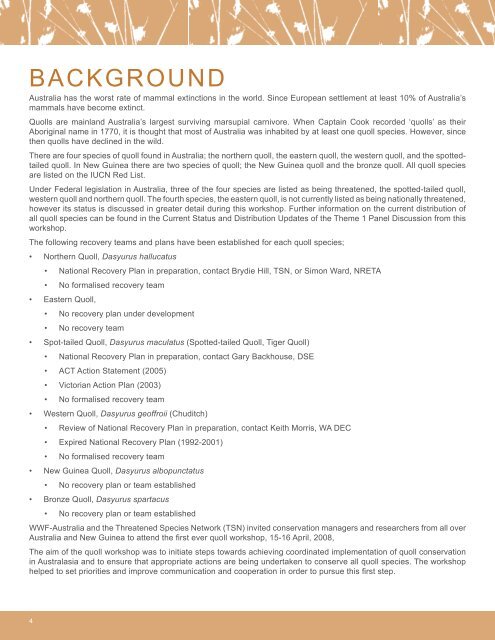Proceedings of the WWF-Australia Quoll Workshop
Proceedings of the WWF-Australia Quoll Workshop
Proceedings of the WWF-Australia Quoll Workshop
You also want an ePaper? Increase the reach of your titles
YUMPU automatically turns print PDFs into web optimized ePapers that Google loves.
BACKGROUND<strong>Australia</strong> has <strong>the</strong> worst rate <strong>of</strong> mammal extinctions in <strong>the</strong> world. Since European settlement at least 10% <strong>of</strong> <strong>Australia</strong>’smammals have become extinct.<strong>Quoll</strong>s are mainland <strong>Australia</strong>’s largest surviving marsupial carnivore. When Captain Cook recorded ‘quolls’ as <strong>the</strong>irAboriginal name in 1770, it is thought that most <strong>of</strong> <strong>Australia</strong> was inhabited by at least one quoll species. However, since<strong>the</strong>n quolls have declined in <strong>the</strong> wild.There are four species <strong>of</strong> quoll found in <strong>Australia</strong>; <strong>the</strong> nor<strong>the</strong>rn quoll, <strong>the</strong> eastern quoll, <strong>the</strong> western quoll, and <strong>the</strong> spottedtailedquoll. In New Guinea <strong>the</strong>re are two species <strong>of</strong> quoll; <strong>the</strong> New Guinea quoll and <strong>the</strong> bronze quoll. All quoll speciesare listed on <strong>the</strong> IUCN Red List.Under Federal legislation in <strong>Australia</strong>, three <strong>of</strong> <strong>the</strong> four species are listed as being threatened, <strong>the</strong> spotted-tailed quoll,western quoll and nor<strong>the</strong>rn quoll. The fourth species, <strong>the</strong> eastern quoll, is not currently listed as being nationally threatened,however its status is discussed in greater detail during this workshop. Fur<strong>the</strong>r information on <strong>the</strong> current distribution <strong>of</strong>all quoll species can be found in <strong>the</strong> Current Status and Distribution Updates <strong>of</strong> <strong>the</strong> Theme 1 Panel Discussion from thisworkshop.The following recovery teams and plans have been established for each quoll species;• Nor<strong>the</strong>rn <strong>Quoll</strong>, Dasyurus hallucatus• National Recovery Plan in preparation, contact Brydie Hill, TSN, or Simon Ward, NRETA• No formalised recovery team• Eastern <strong>Quoll</strong>,• No recovery plan under development• No recovery team• Spot-tailed <strong>Quoll</strong>, Dasyurus maculatus (Spotted-tailed <strong>Quoll</strong>, Tiger <strong>Quoll</strong>)• National Recovery Plan in preparation, contact Gary Backhouse, DSE• ACT Action Statement (2005)• Victorian Action Plan (2003)• No formalised recovery team• Western <strong>Quoll</strong>, Dasyurus ge<strong>of</strong>froii (Chuditch)• Review <strong>of</strong> National Recovery Plan in preparation, contact Keith Morris, WA DEC• Expired National Recovery Plan (1992-2001)• No formalised recovery team• New Guinea <strong>Quoll</strong>, Dasyurus albopunctatus• No recovery plan or team established• Bronze <strong>Quoll</strong>, Dasyurus spartacus• No recovery plan or team established<strong>WWF</strong>-<strong>Australia</strong> and <strong>the</strong> Threatened Species Network (TSN) invited conservation managers and researchers from all over<strong>Australia</strong> and New Guinea to attend <strong>the</strong> first ever quoll workshop, 15-16 April, 2008,The aim <strong>of</strong> <strong>the</strong> quoll workshop was to initiate steps towards achieving coordinated implementation <strong>of</strong> quoll conservationin Australasia and to ensure that appropriate actions are being undertaken to conserve all quoll species. The workshophelped to set priorities and improve communication and cooperation in order to pursue this first step.4
















